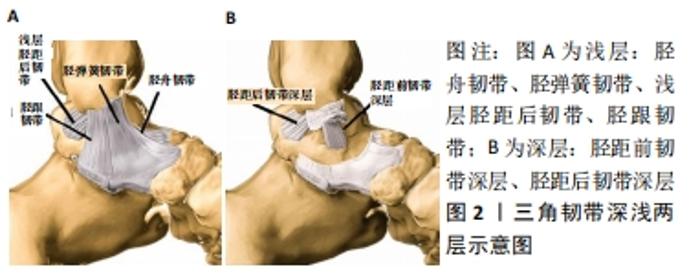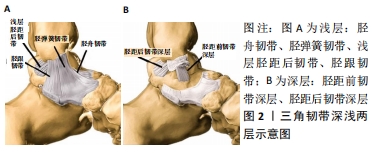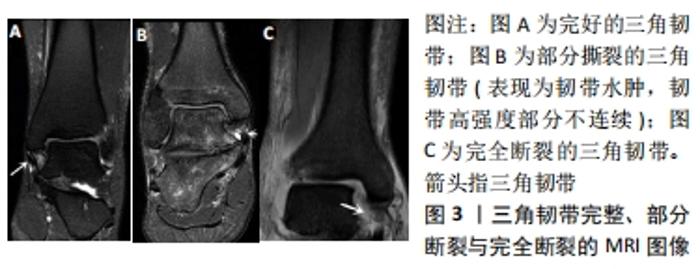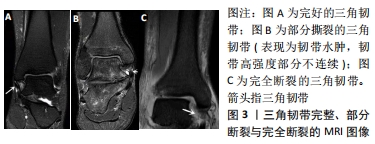Chinese Journal of Tissue Engineering Research ›› 2022, Vol. 26 ›› Issue (11): 1793-1798.doi: 10.12307/2022.368
Previous Articles Next Articles
Ankle joint fracture with deltoid ligament injury: repair and reconstruction
Li Qichen1, Han Shufeng2, Jia Erlong2, Jia Yanan1
- 1Shanxi Medical University, Taiyuan 030001, Shanxi Province, China; 2Department of Orthopedics, the First Hospital of Shanxi Medical University, Taiyuan 030001, Shanxi Province, China
-
Received:2021-01-11Revised:2021-01-13Accepted:2021-03-22Online:2022-04-18Published:2021-12-13 -
Contact:Han Shufeng, Master, Chief physician, Professor, Department of Orthopedics, the First Hospital of Shanxi Medical University, Taiyuan 030001, Shanxi Province, China -
About author:Li Qichen, Master candidate, Shanxi Medical University, Taiyuan 030001, Shanxi Province, China
CLC Number:
Cite this article
Li Qichen, Han Shufeng, Jia Erlong, Jia Yanan. Ankle joint fracture with deltoid ligament injury: repair and reconstruction[J]. Chinese Journal of Tissue Engineering Research, 2022, 26(11): 1793-1798.
share this article
Add to citation manager EndNote|Reference Manager|ProCite|BibTeX|RefWorks

2.1 三角韧带解剖及其功能 踝关节可以抽象为一个冠状面的环(Neer环),由骨与韧带构成,若环的一处被破坏,尚可保持稳定;但若有2处或多处被破坏,则结构变得不稳定。踝关节分为内外两柱:外侧柱包括外踝的骨性结构、下胫腓联合复合体和外侧副韧带;内侧柱由内踝和内侧副韧带(又称三角韧带)组成。在过去,外侧柱被认为是维持踝关节稳定最重要的结构,然而,自1997年以来,人们认识到内侧柱的完整性对于维持踝关节稳定性来说更重要[4-5]。另外,踝关节在水平面上同样存在稳定环。有些旋后-外旋型和旋前-外旋型骨折患者手术修复了外踝骨折和下胫腓联合体,尽管术中非应力位X射线片显示内踝间隙恢复正常,但是进行手动应力试验时仍可以发现踝关节存在外旋或外翻不稳,尤其是距骨前内侧不稳定,而这种不稳定可以改变负重时关节的应力分布,引起踝关节退行性变[6]。 三角韧带是一个大型扇面韧带复合体,起源于内踝,广泛嵌入距骨、跟骨和舟骨[7],其结构与解剖一直存在争议[8-9]。三角韧带分为深浅两层,之间由一个脂肪垫相隔,浅层起于内踝前丘部,远端大部分止于舟骨、足底韧带和载距突,小部分止于距骨;深层粗大,起于内踝后丘及前、后丘间沟,止于距骨内侧的弧形关节面及距骨后内侧结节,走向较水平,见图2。"


浅层的三角韧带由胫舟韧带、胫弹簧韧带、胫距浅韧带和胫跟韧带等4条韧带构成,前两条韧带是普遍存在的,而胫距浅韧带和胫跟韧带的存在在人群中具有差异[9],其中胫舟韧带由于其近端止点非常靠近关节囊,所以单独分离出胫舟韧带较为困难[10]。PANKOVICH和SHIVARAM[11]认为弹簧韧带的纤维是胫舟韧带的一部分,而不是一个单独的韧带。CROMEENS等[12]认为胫舟韧带和胫跟韧带属于同一个解剖结构,故称之为胫跟舟韧带。三角韧带的深层是由胫距前深韧带和胫距后深韧带构成的,其中胫距后深韧带是普遍存在的,深层的胫距前韧带的存在具有个体差异。 三角韧带在维持踝关节正常生物力学稳定性中起着关键作用。其作用主要是限制距骨前、后、外侧外翻移位,以及引导距骨在踝穴中进行正常生理运动[13-15]。具体而言,三角韧带浅层限制了后足外翻,同时也对抗了距骨对胫骨产生的外旋及外翻应力。三角韧带深层是整个韧带最坚韧的部分,也是限制距骨外旋的主要结构,同时可以阻止踝关节的跖屈运动,还限制了距骨发生外翻运动[13,16]。有学者通过尸体研究发现,同时切断三角韧带浅、深层并且对腓骨进行截骨可导致距骨发生大于2 mm的横向移位、以及大于15°的外翻倾斜,其中,无论腓骨状态如何,当深层三角韧带完好时,距骨的状态不会因三角韧带浅层的断裂而改变[17],说明三角韧带深层对距骨在踝关节旋转稳定性中起着更重要的作用。综上,三角韧带对于维持踝关节内侧稳定性,防止严重踝关节损伤中发生距骨半脱位起着重要的作用[18]。 2.2 三角韧带损伤诊断 对于踝关节骨折来说,判断骨折的稳定性是非常重要的。比如,对于旋后-外旋型Ⅱ度踝关节骨折(SER Ⅱ,踝关节骨折Lauge-Hansen分型中的一种,下同)来说,存在外踝骨折,但三角韧带完整,踝关节仍能保持稳定,保守治疗或仅固定外踝骨折就可以获得不错的临床疗效。而SER IV型踝关节骨折包括外踝骨折和内踝结构受损,其踝关节失稳,因此,需要手术治疗恢复踝关节稳定性。体格检查对任何损伤的评估都至关重要,但目前有研究已证实踝关节有无内侧压痛与三角韧带是否断裂无关[19]。 多项研究表明,重力和手动应力X射线片可用于判断踝关节的稳定性,当内踝间隙>4 mm时,就可以诊断踝关节不稳 定[20-21]。应力X射线片需在麻醉状态下进行,运用患者自身质量或者术者手法施加外力进行外旋或外翻的检测。LEBA等[22]对比了手动应力试验和重力应力试验,发现两种试验的影像学结果相似,然而患者在行重力应力试验中疼痛较轻,而且减少了医生受到的射线暴露,因而更胜一筹。ROSA等[23]比较了踝关节骨折患者的超声检查与重力应力X射线片的结果,发现在踝关节背屈轻度外旋状态下超声图像中三角韧带完整患者的内踝间隙为2.7 mm,三角韧带部分断裂的内踝间隙为5.2 mm,三角韧带完全断裂的为5.8 mm,与应力位X射线片的检查结果相比,超声诊断三角韧带断裂敏感性和特异性较高。MRI在三角韧带损伤的诊断中的准确性非常高[24-27]。WARNER等[25]发现,当在普通X射线片(非应力片)上内踝间隙 < 5 mm时,应力位X射线片有更高的假阳性发生率,而MRI比应力位X射线片诊断三角韧带损伤的准确性更高。因此该研究建议,对于在普通X射线片上显示内踝间隙< 5 mm的患者应使用MRI而不是应力位X射线片来评估三角韧带是否损伤。然而,NORTUNEN等[28]发现在应力试验中,内踝间隙<5 mm时三角韧带断裂比例较高,因此不建议在评估SER IV型踝关节骨折中使用MRI判断三角韧带是否损伤。在另一项关于Weber B型踝关节骨折患者MRI表现的研究中,LEE等[26]发现与其他踝关节骨折的患者相比,外踝骨折内固定后存在外翻不稳定的患者中三角韧带前部的损伤程度更高;并且在稳定、轻度不稳定以及高度不稳定骨折之间,三角韧带深层损伤的MRI表现无明显差异。他们推荐了基于MRI的损伤诊断分级标准:0-无损伤;1-韧带水肿;2-部分撕裂,表现为韧带松弛,韧带轮廓不规则,韧带高强度部分不连续;3-韧带完全断裂。图3为三角韧带完整、部分断裂与完全断裂的MRI影像学资料。"


2.3 保守与手术治疗的选择 尽管有研究发现修复外踝骨折和保守治疗内侧损伤可以取得良好的效果,但许多踝关节骨折的患者仍无法进行高水平的运动[29]。当距骨外侧移位大于2 mm时,可能导致踝关节骨性关节炎。并且,有研究报道同时修复三角韧带的患者预后较好。LUO等 [30]在一项对12例伴有内踝损伤的踝关节骨折患者的研究中发现,5例患者在手术修复三角韧带后,完全恢复到了受伤前的运动水平,并且没有患者出现持续性的踝关节疼痛或踝关节不稳定的情况。在许多不稳定的踝关节骨折中,三角韧带浅层完全从内踝撕脱,并且嵌在内踝间隙,阻碍了踝关节的解剖复位[31]。 一些研究报道了踝关节骨折的患者修复三角韧带后的预后情况[31-34]。ZHAO等[32]将接受三角韧带修复的患者与未进行三角韧带修复的患者进行了对比,在平均随访53.7个月后,他们发现非修复组的复位不良率为20.4%,而修复组无复位不良。SHEN等[33]报道了三角韧带缝合锚钉修复后的影像学和临床结果,他们发现术后患者内踝间隙维持良好,临床效果令人满意。同样,YU等[34]对131例三角韧带修复术后的患者进行了一项多中心回顾性研究,结果在最终随访中没有发现患者出现内踝间隙增宽或外翻倾斜角度增加的情况。尽管研究显示踝关节三角韧带修复后的结果令人满意,但尚无统一的修复指征。如果外踝骨折已解剖复位并且下胫腓联合稳定,理论上可以避免应力作用下导致的距骨横向平移,但是实际上仍然可能存在踝关节外翻或外旋不稳的情况。因此,目前大多数学者的管理策略是在下述多种情况下探查和修复三角韧带:即当患者存在踝关节脱位或在应力位X射线片上内踝间隙明显增宽、有组织嵌入内踝间隙阻碍距骨复位、或外踝解剖复位固定后仍然存在踝关节外旋或外翻不稳的情况;以及关节镜下确认三角韧带完全断裂的情况。 另外,尤其对于伴有下胫腓联合损伤的踝关节骨折患者,有学者建议在切开复位内固定处理踝关节损伤时需要修复三角韧带以恢复踝关节稳定性[35-36],其中以Weber B型和C型踝关节骨折中最为常见。Weber B型和C型骨折均已被证明与下胫腓联合破坏有关,其中Weber C型骨折的发生率更高[32,37-38]。与只接受下胫腓螺钉固定而未修复三角韧带的患者相比,下胫腓联合不稳的患者选择修复三角韧带可以明显减少下胫腓联合复位不良等并发症的发生。据报道,放置与取出下胫腓螺钉均具有风险,其中放置下胫腓螺钉可能导致腓动脉穿支的损伤[38]。早期取出螺钉(8周之前)与胫腓关节复位不良有关[39],而超过三四个月取出下胫腓螺钉可能与踝关节背屈范围减少有关[40-41]。去除螺钉的并发症(包括伤口感染、内植物残留以及神经血管的损伤)发生率可以高达23%[42]。最近的文献显示,在常规取出下胫腓螺钉的手术数量逐渐减少,但是,目前术后3个月取出螺钉的手术率仍然高达67%[42]。相比修复三角韧带,行下胫腓螺钉固定的患者术后并发症和复位不良的发生率较高,但是修复三角韧带会延长踝关节骨折手术时间[42-43]。而对于不需要固定下胫腓联合的Weber B型骨折患者修复和不修复三角韧带的术后结果上没有显著差异[44-45]。与未修复三角韧带的患者相比,修复了三角韧带的踝关节骨折患者在内踝间隙、疼痛和功能方面没有显著差异。 修复三角韧带替代下胫腓螺钉固定的好处可能是可以规避下胫腓螺钉使用的相关风险[40,42,46],因此,可以应用非下胫腓螺钉固定的技术,例如suture-button固定术,作为替代方案进行下一步的探索。与放置下胫腓螺钉固定相比,suture-button技术的早期研究表明,其具有更好的功能效果、减轻患者疼痛、降低复位不良发生率、可以更早回归工作岗位以及避免二次手术等优点。值得注意的是,三角韧带修复术的缺点之一是修复手术时间较长。因此,考虑到下胫腓螺钉的上述缺点,以及三角韧带修复术和suture-button固定术的各自优缺点,需要进行一次大样本的随机对照试验,比较在下胫腓联合受损时行三角韧带修复术与suture-button固定术的术后效果。 2.4 不同类型骨折三角韧带损伤治疗方法选择 Danis和Weber基于X射线片上的表现,创建了踝关节骨折分型的方法,把踝关节骨折分为A,B,C三型,与Lauge-Hansen分型依据踝关节骨折损伤机制的不同,该骨折分型方法考虑了腓骨远端骨折相对下胫腓联合的位置关系,由此可以推断损伤机制及三角韧带的损伤情况,其中骨折线的位置越高,踝关节不稳的可能性越大[47-49]。 2.4.1 A型骨折 Danis-Weber A型骨折是指外踝骨折发生在胫骨下关节面下方,并可能伴有倾斜或垂直的内踝骨折。该骨折类型受伤机制通常为踝关节过度内收、内旋,类似Lauge-Hansen旋后-内收型骨折。此类骨折的暴力先作用于外侧踝关节,引起跟腓韧带、距腓前韧带损伤、断裂及腓骨远端骨折,若暴力持续则引起内踝骨折[49-51]。内侧结构的损伤主要表现为内侧踝穴骨与软骨的损伤,内踝常表现为垂直样骨折线,此类骨折合并三角韧带损伤的情况较为少见[50],因此不多做赘述。 2.4.2 B型骨折 Danis-Weber B型骨折,外踝骨折线起自下胫腓联合远端前方并斜向近端,损伤机制类似Lauge-Hansen旋后-外旋型骨折[49-51]。B型骨折可能伴有内踝骨折或三角韧带损伤。如果非负重X射线片提示内踝间隙无明显增宽,应继续完善踝关节应力位X射线片检查,如果内踝间隙>5 mm,则提示三角韧带损伤[20]。 Weber B型骨折的保守和手术治疗尚存争议,目前的共识是,对于合并有三角韧带或内踝骨折的不稳定骨折行切开复位内固定的手术治疗,但对于是否手术修复三角韧带尚存在分歧。BUTLER等[52]通过尸体研究发现,对SER-IV型踝关节骨折进行三角韧带修复可以帮助直接复位,并稳定胫距关节,恢复距骨在胫距关节中的位置关系以及所有平面上的稳定性,这是单独复位固定外踝所不能实现的。 WANG等[44]研究发现,伴有三角韧带损伤的SER-IV型踝关节骨折患者如修复三角韧带浅层,可使三角韧带浅层的解剖结构和内侧踝关节间隔恢复正常,确保了三角韧带深层在合理的张力下得以愈合并恢复了踝关节的稳定性。然而SUN等[53]通过对41例Weber B型骨折伴有三角韧带损伤的患者进行前瞻性队列研究,其中12例行三角韧带浅层修复术,16例行三角韧带深层增强修复术,13例三角韧带损伤未作处理,术后随访3年,结果显示组间术后踝关节活动范围、内踝间隙、临床和功能差异无统计学意义,这项研究结果不支持常规探查和修复三角韧带。因此,对于此类骨折修复三角韧带的必要性,尚需大样本的随机对照试验证明。另外,对于三角韧带深层增强修复的疗效目前尚不清楚[53-55],仍需进一步研究。DABASH等[56]研究表明,由于解剖结构的特殊性,导致其探查难度大,且切口较大,三角韧带深层不能得到较好的修复。同样,汤俊君等[57]研究认为三角韧带浅层修复较不修复和深层修复的效果好。但是,理论上,深层三角韧带在维持踝关节内侧稳定性方面起着更重要的作用,单纯修复三角韧带浅层不能完全恢复踝关节稳定性。孙冶智等[58]的研究发现完全修复三角韧带组和三角韧带深层修复组较单纯修复三角韧带浅层组有更好的效果和预后。不可否认的是,由于内踝结构的复杂性,造成修复三角韧带深层的难度较大。但是作者相信随着技术的不断发展,修复三角韧带深层的技术难题也会逐步得到解决。 2.4.3 C型骨折 Danis-Weber C型骨折发生在胫骨下关节面水平上方,常伴有下胫腓联合损伤、三角韧带损伤和内踝骨折,类似Lauge-Hansen旋前-外旋型和旋前-外展型骨折[47-49,51]。旋前-外旋型骨折的损伤机制是当足处于旋前位时,距骨受到外旋的作用力,使得距骨向外侧旋转、移位[59],从而造成踝关节内侧的撕脱骨折或三角韧带损伤,若暴力持续作用可依次造成下胫腓前韧带、腓骨、下胫腓后韧带以及后踝等结构的损伤。因此对于旋前-外旋型骨折来说,单纯的内踝撕脱骨折或者三角韧带损伤较为少见,通常合并下胫腓联合、外踝等结构的损伤。由此来说,三角韧带的修复对此类骨折尤为重要[60]。但有学者认为,对于患有旋前外旋型Ⅲ、Ⅳ度踝关节骨折的患者来说,在外踝及下胫腓联合螺钉固定后,三角韧带深层损伤不会影响小于45岁患者的中期疗效。因此,对于踝关节功能要求较高的人群,诸如专业运动员,踝关节骨折后伴有的三角韧带损伤建议修复受损的三角韧带,但对于普通人群尚且存在争议[31]。 旋前-外展型踝关节骨折的损伤机制与旋前-外旋型骨折类似,损伤时足处于旋前位,距骨受到强烈的外展外力,首先导致内踝发生撕脱骨折或三角韧带断裂,接下来导致包括下胫腓韧带不全损伤或全部断裂以及腓骨骨折。对于此种损伤来说,骨折复位后,踝关节解剖关系恢复良好,且内踝间隙<2 mm者,三角韧带损伤无需修补[5]。 2.5 三角韧带损伤修复方法 现如今,提出几种修复三角韧带断裂、损伤的技术,如简单的初级修复(经骨道缝线或钢丝修补术)、锚钉修复、三角韧带重建以及关节镜技术。 2.5.1 经骨道缝线或钢丝修补术 此方法是用克氏针在内踝后丘或(和)三角韧带的距骨止点处钻两三个2 mm的骨孔,对损伤的三角韧带使用2根钢丝或不吸收缝线穿过韧带和骨孔进行缝合。李凡等[61]对18例伴三角韧带完全断裂的踝关节骨折患者采用上述方法修补三角韧带,术后用Mazur评分系统评估手术疗效,优8例,良8例,可2例。此方法修复三角韧带损伤具有一定的疗效,不足之处在于操作复杂,固定时用缝线强度较弱,而运用钢丝固定时,拧紧过程中钢丝可能发生断裂,且固定位置不佳可能造成医源性踝关节炎和关节屈伸活动受限等并发症。此方法近年已少有报道。 2.5.2 带线锚钉修复三角韧带 带线锚钉技术是目前临床上修复三角韧带最常用的技术,而且修复后效果较为理想[33]。带线锚钉含有高低螺纹,末端带有尾线,修复韧带时可将锚钉主体完全置入骨骼中,几乎不会对韧带愈合产生影响,而且固定技术相对简单、损伤小。锚钉固定术后可以较早恢复功能锻炼,有助于功能恢复,降低关节僵硬等术后并发症的发生率,避免了传统方法修复三角韧带强度过高过低的缺陷,提高了手术疗效。同时,韧带起止点损伤应用带线锚钉进行修复时,不仅可以使韧带恢复连续性,而且也在一定程度上对韧带进行了重建[62]。有学者认为,对于同时伴有内侧韧带损伤和下胫腓联合分离的踝关节骨折,可以应用三角韧带锚钉修复术替代下胫腓螺钉固定术。JONES等[55]通过对比15例经下胫腓螺钉固定的旋后-外旋型4度(Weber b型)患者及12例进行三角韧带修复患者的手术疗效(包括主观、功能、放射学结果),后者可以减少成本,并且避免了二次手术取出下胫腓螺钉的风险。国内孙旭等[63]通过类似的试验对比得到相同结论。 具体修复方式因术者和患者具体情况而异[16,33-34,38]。最近有关修复方法描述的共同点为通过带线锚钉固定在胫骨远端内侧处,进而解剖修复三角韧带;不同点在于对手术切口位置的选择,是否对深层、浅层的韧带都进行修复,如何处理跟骨撕脱骨折,以及带线锚钉的固定位置及数量等。具体何种修复方式对患者受益最佳,尚需对大量临床病例资料的收集和整理。 2.5.3 三角韧带重建 三角韧带损伤的修复方法,国内学者较多采用带线锚钉修复法,而对三角韧带重建的研究相对较少。当踝关节三角韧带受损严重时,除起、止点保有少部分韧带外,其余部分均发生断裂,造成修复韧带困难很大,因此重建三角韧带的方法成为解决三角韧带损伤新方案,尤其对于旋转不稳定的患者来说重建三角韧带尤为重要。韧带重建包括肌腱移植(包括自体肌腱移植和同种异体肌腱移植)或人工肌腱重建,主要用于治疗三角韧带损伤引起的慢性踝关节不稳,手术较为复杂。目前有4种技术常用于三角韧带的重建,分别是Witber-G、Deland、KioKa和Hintermann技术。各项技术的差别在于取材解剖部位的不同[64-65]。比较三角韧带修复与重建的优缺点,尚需大量临床病例资料的积累和总结。当三角韧带损伤通过非手术治疗效果不佳,并且无法直接修补三角韧带时,使用三角韧带重建可以作为最后的保留手段。 2.5.4 关节镜 随着踝关节镜技术的不断进步,踝关节镜在评估踝关节骨折的严重程度、复杂性和韧带损伤方面具有一定的优势,尤其是在不合并踝关节骨折,影像学检查不能明确有无三角韧带损伤的病例中,可以通过踝关节镜直视,判断三角韧带的状态[66-67]。另外,踝关节镜可以较好地探查和处理不稳定骨折中存在的关节内骨软骨损伤,以及一些可能造成踝关节不稳定的病变,如下胫腓联合损伤,为踝关节骨折以及三角韧带损伤的诊疗提供新方案[68-69]。"

| [1] COURT-BROWN CM, CAESAR B. Epidemiology of adult fractures: A review. Injury. 2006;37(8):691-697. [2] LOREN GJ, FERKEL RD. Arthroscopic assessment of occult intra-articular injury in acute ankle fractures. Arthroscopy. 2002;18(4):412-421. [3] RIGBY R, SCOTT R. Role for primary repair of deltoid ligament complex in ankle fractures.Clin Podiatr Med Surg. 2018;35(2):183-197. [4] LAMPRIDIS V, GOUGOULIAS N, SAKELLARIOU A. Stability in ankle fractures: Diagnosis and treatment. EFORT Open Rev. 2018;3(5):294-303. [5] 张云, 杨云峰. 踝关节骨折合并急性三角韧带损伤的诊断和治疗进展 [J]. 中国修复重建外科杂志,2017,31(5):624-628. [6] BASTIAS GF, FILIPPI J.Acute deltoid ligament repair in ankle fractures.Foot Ankle Clin. 2020;25(4):597-612. [7] CAMPBELL K, MICHALSKI M, WILSON K, et al. The ligament anatomy of the deltoid complex of the ankle: A qualitative and quantitative anatomical study. J Bone Joint Surg Am. 2014;96(8):e62. [8] LEE S, LIN J, HAMID K, et al. Deltoid ligament rupture in ankle fracture: Diagnosis and management. J Am Acad Orthop Surg. 2019;27(14):e648-e658. [9] YAMMINE K.The morphology and prevalence of the deltoid complex ligament of the ankle. Foot Ankle Spec. 2017;10(1):55-62. [10] PANCHANI P, CHAPPELL T, MOORE G, et al. Anatomic study of the deltoid ligament of the ankle. Foot Ankle Int. 2014;35(9):916-921. [11] PANKOVICH AM, SHIVARAM MS.Anatomical basis of variability in injuries of the medial malleolus and the deltoid ligament. I. Anatomical studies. Acta Orthop Scand. 1979;50(2):217-223. [12] CROMEENS B, KIRCHHOFF C, PATTERSON R, et al. An attachment-based description of the medial collateral and spring ligament complexes. Foot Ankle Int. 2015;36(6):710-721. [13] FÖSEL A, SEIDEL A, ATTINGER M, et al. Ankle joint pressure in supination-external rotation injuries: A biomechanical study in an unrestrained cadaver model. Foot Ankle Spec. 2020;1938640020950183. [14] TAKAO M, OZEKI S, OLIVA X, et al. Strain pattern of each ligamentous band of the superficial deltoid ligament: A cadaver study. BMC Musculoskelet Disord. 2020; 21(1):289. [15] LAMOTHE J, BAXTER J, GILBERT S, et al. Effect of complete syndesmotic disruption and deltoid injuries and different reduction methods on ankle joint contact mechanics. Foot Ankle Int. 2017;38(6):694-700. [16] LACK W, PHISITKUL P, FEMINO JE. Anatomic deltoid ligament repair with anchor-to-post suture reinforcement: Technique tip. Iowa Orthop J. 2012;32:227-230. [17] MICHELSON JD, VARNER KE, CHECCONE M. Diagnosing deltoid injury in ankle fractures: The gravity stress view. Clin Orthop Relat Res. 2001;(387):178-182. [18] HAYNES J, GOSSELIN M, CUSWORTH B, et al. The arterial anatomy of the deltoid ligament: A cadaveric study. Foot Ankle Int. 2017;38(7):785-790. [19] DEANGELIS N, ESKANDER M, FRENCH B. Does medial tenderness predict deep deltoid ligament incompetence in supination-external rotation type ankle fractures? J Orthop Trauma. 2007;21(4):244-247. [20] GILL J, RISKO T, RADUCAN V, et al. Comparison of manual and gravity stress radiographs for the evaluation of supination-external rotation fibular fractures.J Bone Joint Surg Am. 2007;89(5):994-999. [21] PITAKVEERAKUL A, KUNGWAN S, ARUNAKUL P, et al. Radiographic parameters in gravity stress view of the ankle: Normative data. Foot Ankle Surg. 2019;25(6): 819-825. [22] LEBA T, GUGALA Z, MORRIS R, et al. Gravity versus manual external rotation stress view in evaluating ankle stability: A prospective study. Foot Ankle Spec. 2015;8(3): 175-179. [23] ROSA I, RODEIA J, FERNANDES PX, et al. Ultrasonographic assessment of deltoid ligament integrity in ankle fractures. Foot Ankle Int. 2020;41(2):147-153. [24] JEONG M, CHOI Y, KIM Y, et al. Deltoid ligament in acute ankle injury: Mr imaging analysis. Skeletal radiology. 2014;43(5):655-663. [25] WARNER S, GARNER M, FABRICANT P, et al. The diagnostic accuracy of radiographs and magnetic resonance imaging in predicting deltoid ligament ruptures in ankle fractures. HSS J. 2019;15(2):115-121. [26] LEE T, JANG K, CHOI G, et al. The contribution of anterior deltoid ligament to ankle stability in isolated lateral malleolar fractures. Injury. 2016;47(7):1581-1585. [27] BÄCKER H, VOSSELLER J, BONEL H, et al. Weightbearing radiography and mri findings in ankle fractures. Foot Ankle Spec. 2020;1938640020921571. [28] NORTUNEN S, LEPOJÄRVI S, SAVOLA O, et al. Stability assessment of the ankle mortise in supination-external rotation-type ankle fractures: Lack of additional diagnostic value of mri. J Bone Joint Surg Am. 2014;96(22):1855-1862. [29] HONG C, ROY S, NASHI N, et al. Functional outcome and limitation of sporting activities after bimalleolar and trimalleolar ankle fractures. Foot Ankle Int. 2013;34(6):805-810. [30] LUO G, NI W, GUO S, et al. Effectiveness of repairing the deep layer of deltoid ligament by suture anchor repair method in treatment of mixed medial injury associated with ankle fractures. Zhongguo Xiu Fu Chong Jian Wai Ke Za Zhi. 2020;34(11):1387-1391. [31] HSU AR, LAREAU CR, ANDERSON RB. Repair of acute superficial deltoid complex avulsion during ankle fracture fixation in national football league players. Foot Ankle Int. 2015;36(11):1272-1278. [32] ZHAO HM, LU J, ZHANG F, et al. Surgical treatment of ankle fracture with or without deltoid ligament repair: A comparative study. BMC Musculoskelet Disord. 2017;18(1):543. [33] SHEN JJ, GAO YB, HUANG JF, et al. Suture anchors for primary deltoid ligament repair associated with acute ankle fractures. Acta Orthop Belg. 2019;85(3):387-391. [34] YU GR, ZHANG MZ, AIYER A, et al. Repair of the acute deltoid ligament complex rupture associated with ankle fractures: A multicenter clinical study. J Foot Ankle Surg. 2015;54(2):198-202. [35] FITZPATRICK E, GOETZ JE, SITTAPAIROJ T, et al. Effect of posterior malleolus fracture on syndesmotic reduction: A cadaveric study. J Bone Joint Surg Am. 2018;100(3):243-248. [36] SAGI HC, SHAH AR, SANDERS RW. The functional consequence of syndesmotic joint malreduction at a minimum 2-year follow-up.J Orthop Trauma. 2012;26(7):439-443. [37] WU K, LIN J, HUANG J, et al. Evaluation of transsyndesmotic fixation and primary deltoid ligament repair in ankle fractures with suspected combined deltoid ligament injury. J Foot Ankle Surg. 2018;57(4):694-700. [38] WOO S, BAE S, CHUNG H. Short-term results of a ruptured deltoid ligament repair during an acute ankle fracture fixation. Foot Ankle Int. 2018;39(1): 35-45. [39] SCHEPERS T.To retain or remove the syndesmotic screw: A review of literature. Arch Orthop Trauma Surg. 2011;131(7):879-883. [40] MANJOO A, SANDERS DW, TIESZER C, et al. Functional and radiographic results of patients with syndesmotic screw fixation: Implications for screw removal.J Orthop Trauma. 2010;24(1):2-6. [41] MILLER A, PAUL O, BORAIAH S, et al.Functional outcomes after syndesmotic screw fixation and removal. J Orthop Trauma. 2010;24(1):12-16. [42] WALLEY KC, HOFMANN KJ, VELASCO BT, et al. Removal of hardware after syndesmotic screw fixation: A systematic literature review. Foot Ankle Spec. 2017;10(3):252-257. [43] DIAB HS. Suture anchor repair for ruptured deltoid ligament in pronation ankle fractures. 2017;28(5):459-464. [44] WANG X, ZHANG C, YIN JW, et al. Treatment of medial malleolus or pure deltoid ligament injury in patients with supination-external rotation type iv ankle fractures. Orthop Surg. 2017;9(1):42-48. [45] CHANG XB, WANG QY, XI HB, et al. [operation-effect analysis of 21 patients with ankle fracture and complete rupture of deltoid ligament].Zhongguo Gu Shang. 2020;33(7):655-658. [46] TUCKER A, STREET J, KEALEY D, et al. Functional outcomes following syndesmotic fixation: A comparison of screws retained in situ versus routine removal - is it really necessary? Injury.2013;44(12):1880-1884. [47] TARTAGLIONE J, ROSENBAUM A, ABOUSAYED M, et al. Classifications in brief: Lauge-hansen classification of ankle fractures. Clin Orthop Relat Res. 2015; 473(10):3323-3328. [48] WEBER BG. Die verletzungen des oberen sprunggelenkes. Aktuelle Probl Chir. 1972;3:1-241. [49] DANIS R. Les fractures malleolaires.//DANIS R, ed. Thorie et practique de l`osteosynthése. 1949:133-165. [50] ZHANG Y, YANG Y. Progress of diagnosis and treatment of ankle fractures combined with acute deltoid ligament injury. Zhongguo Xiu Fu Chong Jian Wai Ke Za Zhi. 2017;31(5):624-628. [51] LAUGE-HANSEN N. Fractures of the ankle. Ii. Combined experimental-surgical and experimental-roentgenologic investigations. Arch Surg. 1950; 60(5):957-985. [52] BUTLER BA, HEMPEN EC, BARBOSA M, et al. Deltoid ligament repair reduces and stabilizes the talus in unstable ankle fractures.J Orthop. 2019;17:87-90. [53] SUN X, LI T, SUN Z, et al. Does routinely repairing deltoid ligament injuries in type b ankle joint fractures influence long term outcomes? . 2018;49(12):2312-2317. [54] LITTLE M, BERKES M, SCHOTTEL P, et al. Anatomic fixation of supination external rotation type iv equivalent ankle fractures. J Orthop Trauma. 2015;29(5):250-255. [55] JONES C, NUNLEY J. Deltoid ligament repair versus syndesmotic fixation in bimalleolar equivalent ankle fractures. J Orthop Trauma. 2015;29(5): 245-249. [56] DABASH S, ELABD A, POTTER E, et al. Adding deltoid ligament repair in ankle fracture treatment: Is it necessary? A systematic review.Foot Ankle Surg. 2019; 25(6):714-720. [57] 汤俊君, 吴克俭, 张建, 等. 不同方式修复踝关节旋后外旋型ⅳ度骨折伴三角韧带完全断裂的初步疗效比较 [J]. 中华创伤骨科杂志, 2016, 18(6):470-475. [58] 孙冶智,余磊,王伟,等.不同方式治疗踝关节骨折伴三角韧带完全断裂的临床效果观察[J].中国现代手术学杂志,2018,22(1):41-44. [59] BOSZCZYK A, FUDALEJ M, KWAPISZ S, et al. Ankle fracture - correlation of lauge-hansen classification and patient reported fracture mechanism. Forensic Sci Int. 2018;282:94-100. [60] 林文,于沈敏,蔡兵,等.锚钉修复三角韧带结合内固定治疗旋前外旋ⅳ度踝关节骨折 [J]. 创伤外科杂志,2017,19(1):61-63. [61] 李凡,勘武生,黄珩,等.伴三角韧带完全断裂的踝关节骨折的治疗[J]. 中国矫形外科杂志,2009,17(24):1906-1908. [62] VEGA J, GOLANÓ P, PELLEGRINO A, et al. All-inside arthroscopic lateral collateral ligament repair for ankle instability with a knotless suture anchor technique. Foot Ankle Int. 2013;34(12):1701-1709. [63] 孙旭, 李庭, 孙志坚, 等. 三角韧带加强修补治疗合并三角韧带损伤及下胫腓分离的踝关节骨折 [J]. 中华医学杂志,2018,98(39):3192-3196. [64] BAUMFELD D, BAUMFELD T, CANGUSSÚ J, et al. Does foot position and location of measurement influence ankle medial clear space?. Foot Ankle Spec. 2018;11(1):32-36. [65] JUNG HG, PARK JT, EOM JS, et al. Reconstruction of superficial deltoid ligaments with allograft tendons in medial ankle instability: A technical report. Injury. 2016;47(3):780-783. [66] KUSNEZOV NA, EISENSTEIN ED, DIAB N, et al. Medial malleolar fractures and associated deltoid ligament disruptions: Current management controversies. Orthopedics. 2017;40(2):e216-e222. [67] SCHAIRER WW, NWACHUKWU BU, DARE DM, et al. Arthroscopically assisted open reduction-internal fixation of ankle fractures: Significance of the arthroscopic ankle drive-through sign.Arthrosc Tech. 2016;5(2):e407-412. [68] CHIANG C, TZENG Y, JEFF LIN C, et al. Arthroscopic reduction and minimally invasive surgery in supination-external rotation ankle fractures: A comparative study with open reduction.Arthroscopy. 2019;35(9):2671-2683. [69] CHAN KB, LUI TH. Role of ankle arthroscopy in management of acute ankle fracture.Arthroscopy. 2016;32(11):2373-2380. |
| [1] | Wen Xu, Shen Jing. Application of nano-silver antibacterial hydrogel dressing combined with recombinant human basic fibroblast growth factor on wound healing after debridement of open ankle fracture [J]. Chinese Journal of Tissue Engineering Research, 2021, 25(29): 4638-4643. |
| [2] | He Yi, Zheng Cong, He Minhui, Lu Ruijun, Huang Jianrong. Screw internal fixation and conservative treatment of posterior ankle fractures: differences in ankle joint function and plantar pressure [J]. Chinese Journal of Tissue Engineering Research, 2021, 25(27): 4379-4385. |
| [3] | Wang Guixin, He Jinquan. Diagnosis and treatment of deltoid ligament injury of ankle joint [J]. Chinese Journal of Tissue Engineering Research, 2019, 23(20): 3235-3241. |
| Viewed | ||||||
|
Full text |
|
|||||
|
Abstract |
|
|||||